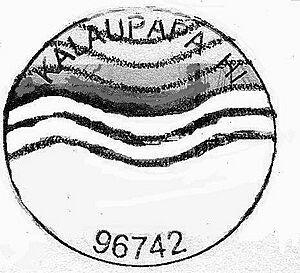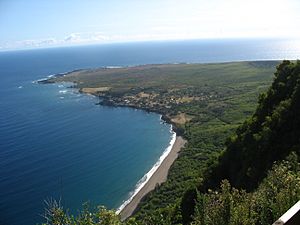Kalaupapa, Hawaii facts for kids
Kalaupapa is a small community located on the island of Molokaʻi in Hawaii. It's part of Kalawao County. This place is famous because, starting in 1866, it became a special settlement for people who had a disease called leprosy, also known as Hansen's disease.
Back then, people didn't understand leprosy very well. They thought it was highly contagious and had no cure. To stop it from spreading, the Hawaiian government decided to send people with severe cases of leprosy to Kalaupapa, isolating them from others. This area is now protected as the Kalaupapa National Historical Park. Even though fewer people live there now, Kalaupapa still has its own post office.
Quick facts for kids
Kalaupapa
|
|
|---|---|

Most of the village of Kalaupapa as seen from an airplane. This photo also includes a section of the sea cliffs that form a natural barrier between the Kalaupapa Peninsula and "Topside" Molokaʻi.
|
|
| Country | United States |
| State | Hawaii |
| County | Kalawao |
| Elevation | 66 ft (20 m) |
| Population
(2020)
|
|
| • Total | 82 |
| Time zone | UTC-10 (Hawaii-Aleutian) |
| ZIP codes |
96742
|
| GNIS feature ID | 360096 |
Contents
The Kalaupapa Settlement for Leprosy
Kalaupapa was once a special village for people with leprosy. At its busiest, about 1,200 men, women, and children were sent to live on the Kalaupapa Peninsula. This rule was put in place by King Kamehameha V and lasted until 1969.
Today, only a few people who once had leprosy still live there. The settlement is now part of the Kalaupapa National Historical Park.
The first settlement for people with leprosy was in Kalawao, on the eastern side of the peninsula. Father Damien, a priest, came to live and help there in 1873. Later, the settlement moved to where the current village is, which used to be a Hawaiian fishing village. Other helpers included Mother Marianne Cope and doctor Arthur Albert St. Mouritz.
Before the rule of mandatory isolation ended in 1969, the government thought about closing the settlement completely. However, people like entertainer Don Ho and newsman Don Picken helped make sure that residents who wanted to could stay there for the rest of their lives. They pointed out that many residents had physical scars from the disease, which would make it hard for them to live easily in regular society.
Over many years, more than 8,500 people from across the Hawaiian islands who were diagnosed with leprosy were sent to Kalaupapa. They were separated from their families and lives.
Geography of Kalaupapa
The Kalaupapa Peninsula is one of the most isolated places in Hawaii. This is because of its amazing sea cliffs, which are about 2,000 feet (610 meters) tall. These cliffs are among the tallest in the world and make it very hard to get to Kalaupapa.
Scientists used to think these cliffs were shaped by wind and water. But now, they believe the cliffs formed after a large part of the northern island fell into the sea. The small islands offshore, like 'Ōkala, Mōkapu, and Huelo, support this idea. These islands are home to rare plants, like the native loulu palm, that have been on Molokaʻi for thousands of years.
About 230,000 to 300,000 years ago, an underwater volcano called Pu’u’uao erupted. Its hot, fast-flowing lava created the flat, triangle-shaped land that became the Kalaupapa Peninsula. This land eventually connected to the main part of Molokaʻi.
One big challenge for the people living in Kalaupapa was finding and keeping fresh water. There's a lake in Kauhakō Crater, a main feature of the peninsula. This lake has the deepest depth-to-area ratio of any lake on Earth. It was a source of fresh water at different times in Kalaupapa's history.
Accessing the Kalaupapa Peninsula
Before the Kalaupapa Airport was built in 1935, the only ways to reach the peninsula were by boat or by climbing down the Kalaupapa Pali trail. Today, you need a special permit to arrive by boat. It's also against the rules to come within 1,300 feet (400 meters) of the Kalaupapa shoreline.
The Kalaupapa Trail
The Kalaupapa Pali Trail is about 3.5 miles (5.6 kilometers) long and is the only land path into Kalaupapa. The trail has 26 switchbacks, which are sharp turns, and drops about 2,000 feet (610 meters) in elevation.
The National Park Service says this hike is very difficult. The path is steep and uneven, and conditions can change. Many visitors also ride Molokaʻi mules down the trail into Kalaupapa.
Trail Collapse
On December 25, 2018, a postal worker found that a large landslide had badly damaged the trail. The landslide destroyed a bridge on one of the switchbacks, and the trail has been closed ever since.
Luckily, supply deliveries to Kalaupapa were not affected. Supplies arrive by barge once a year in the summer and by plane weekly.
Kalaupapa National Historical Park
The Kalaupapa National Historical Park was created on December 22, 1980. The park only allows 100 visitors each day. Every visitor needs a sponsor, which can be a resident or one of the tour companies.
The National Park Service shares some important things to know before you visit:
- People under 16 years old are not allowed to visit Kalaupapa.
- There are no medical facilities in Kalaupapa. Getting emergency medical help can take hours and might need a helicopter flight to another island.
- There are no places to eat or shop in Kalaupapa. You must bring all your own food and supplies, and take all your trash out with you.
- You are not allowed to take pictures of the patient-residents or their property without their clear written permission.
- The 3.5-mile (5.6-kilometer) trail to the park is very steep and hard, with uneven surfaces. Rock and mudslides are common. Hiking the trail is physically demanding, so think carefully about your fitness level before you start.
- You can only stay overnight if you are a guest of a resident.
See also
 In Spanish: Kalaupapa para niños
In Spanish: Kalaupapa para niños






